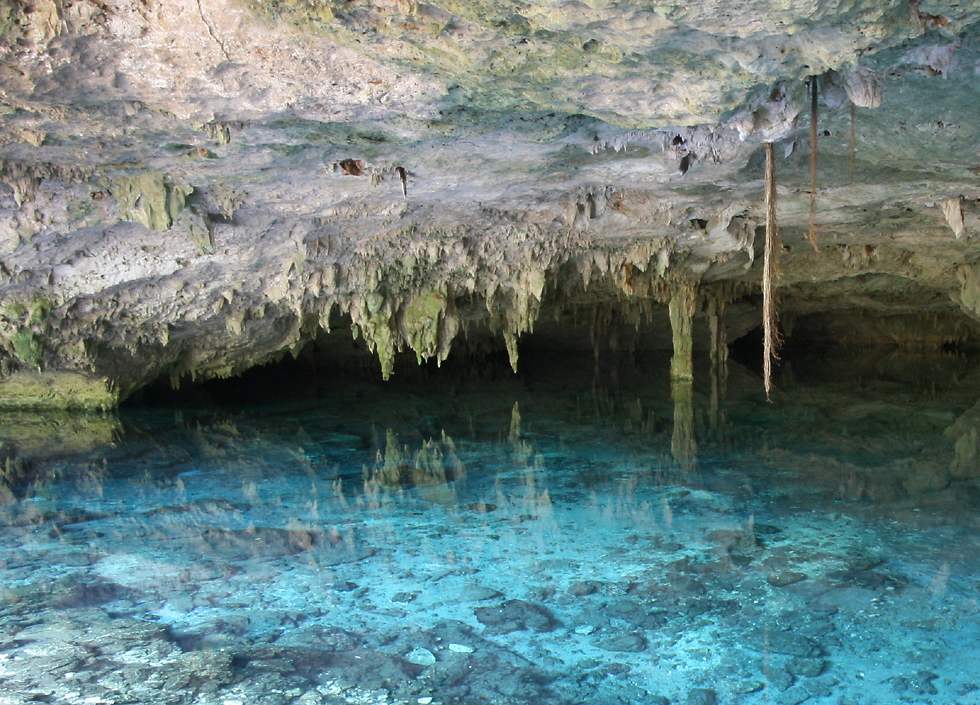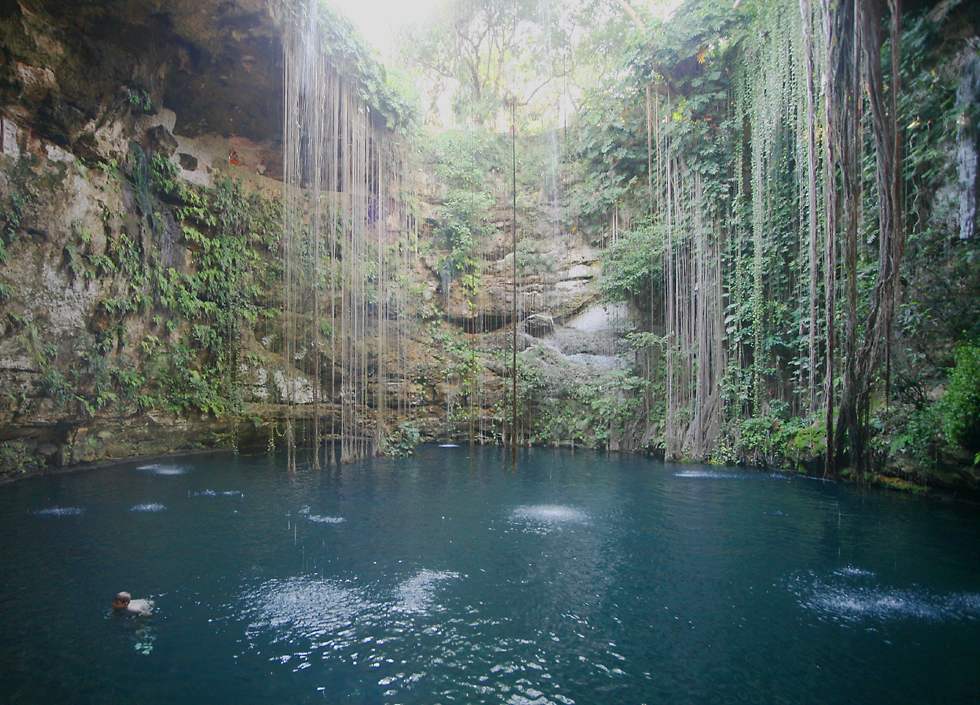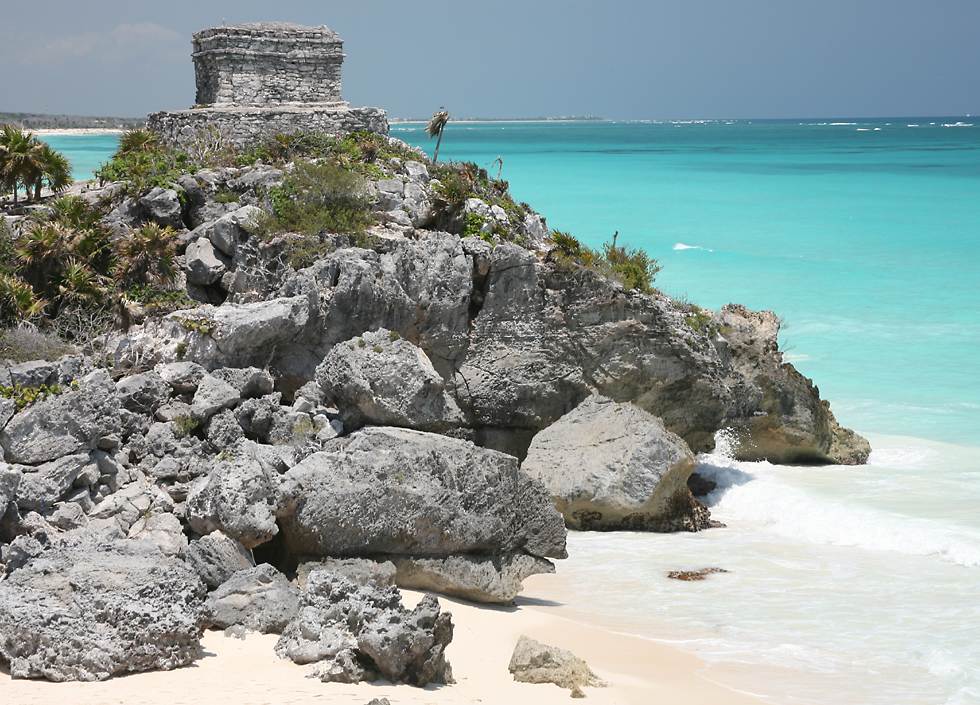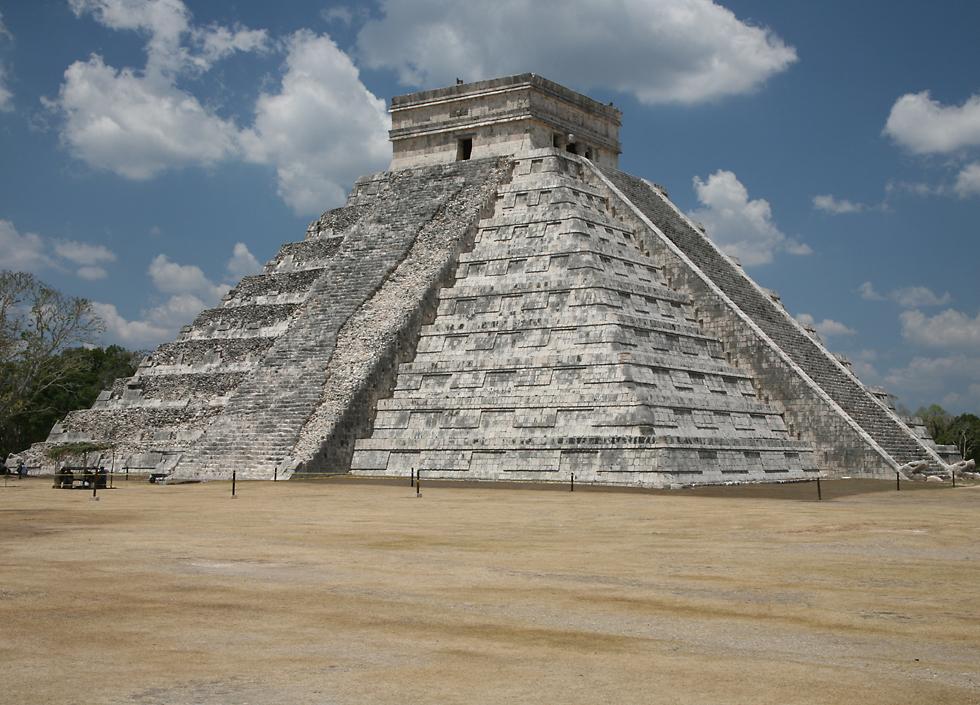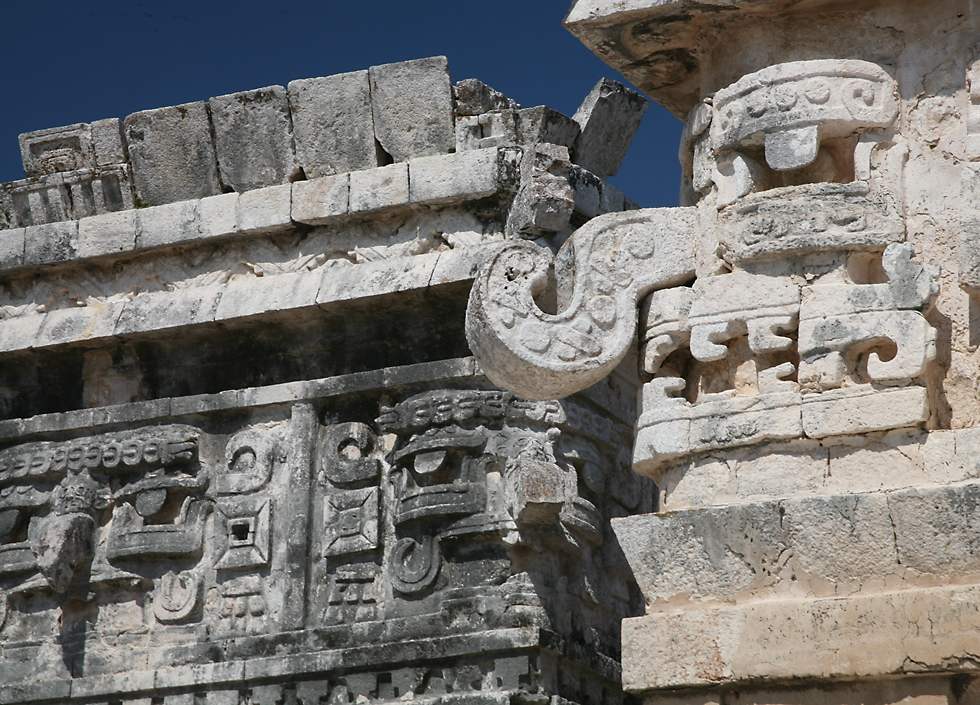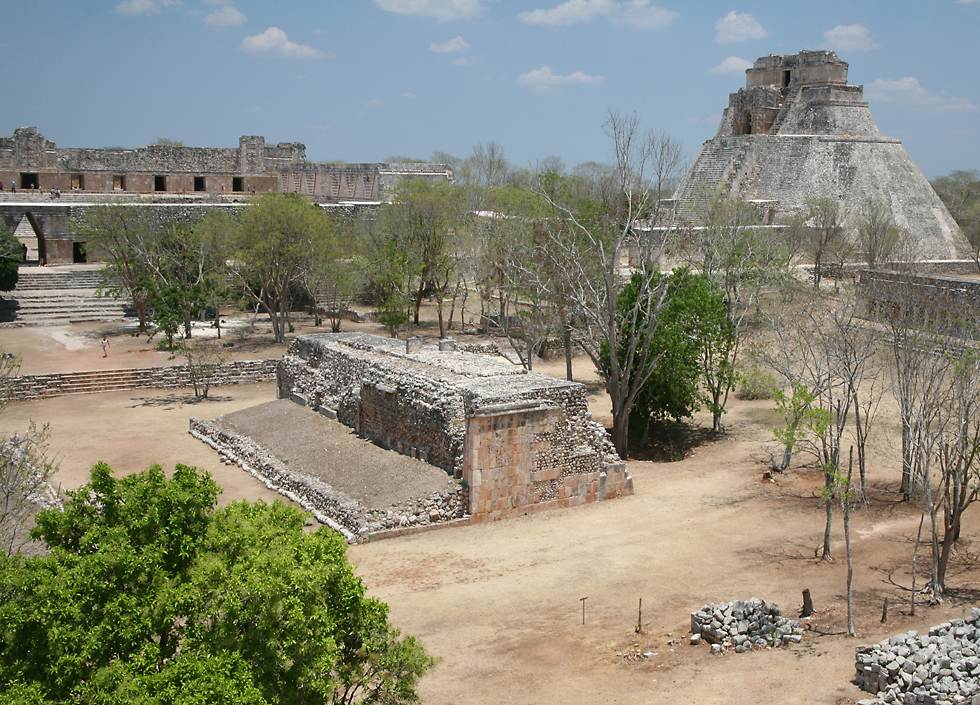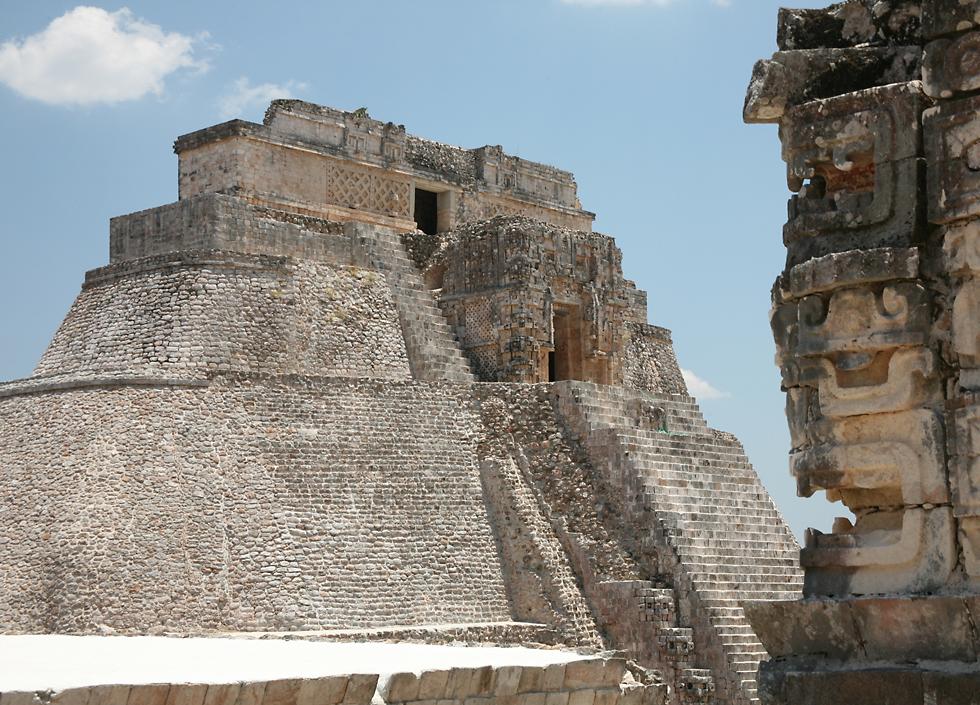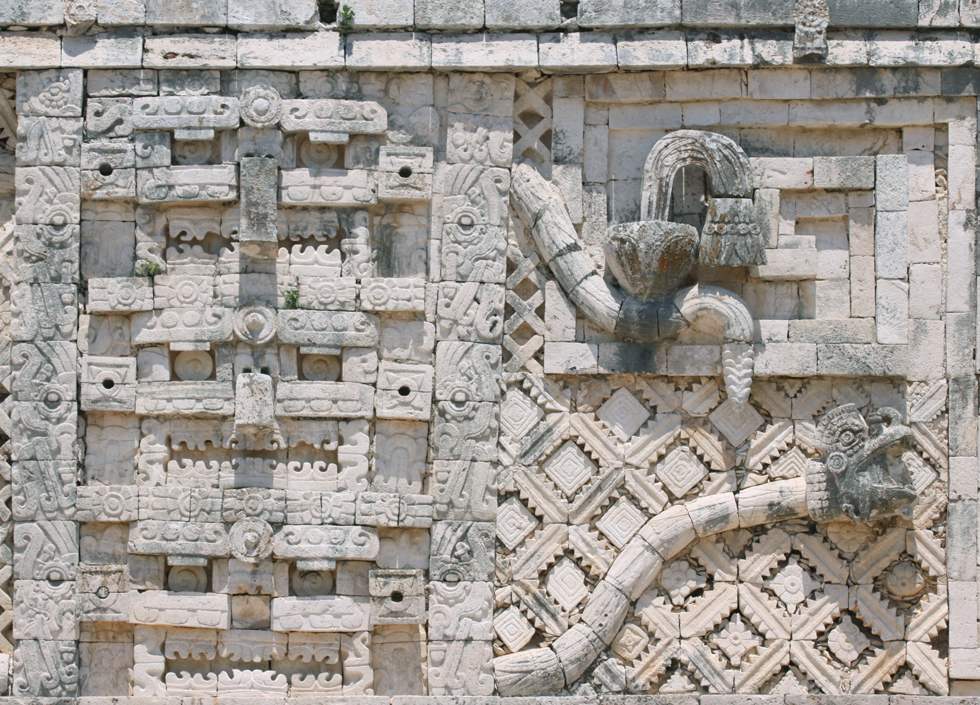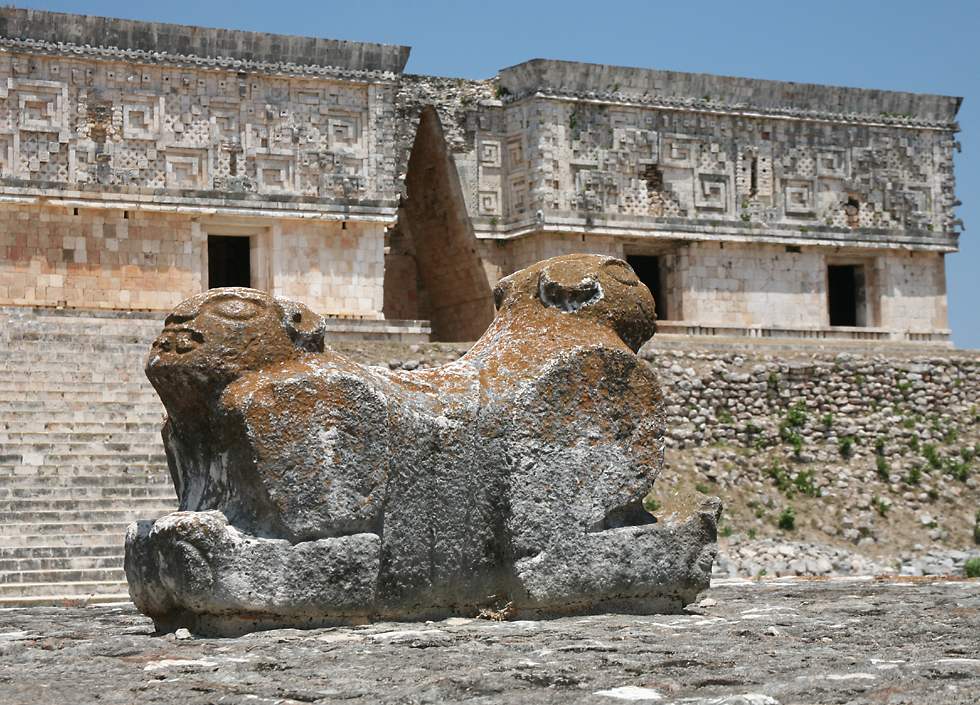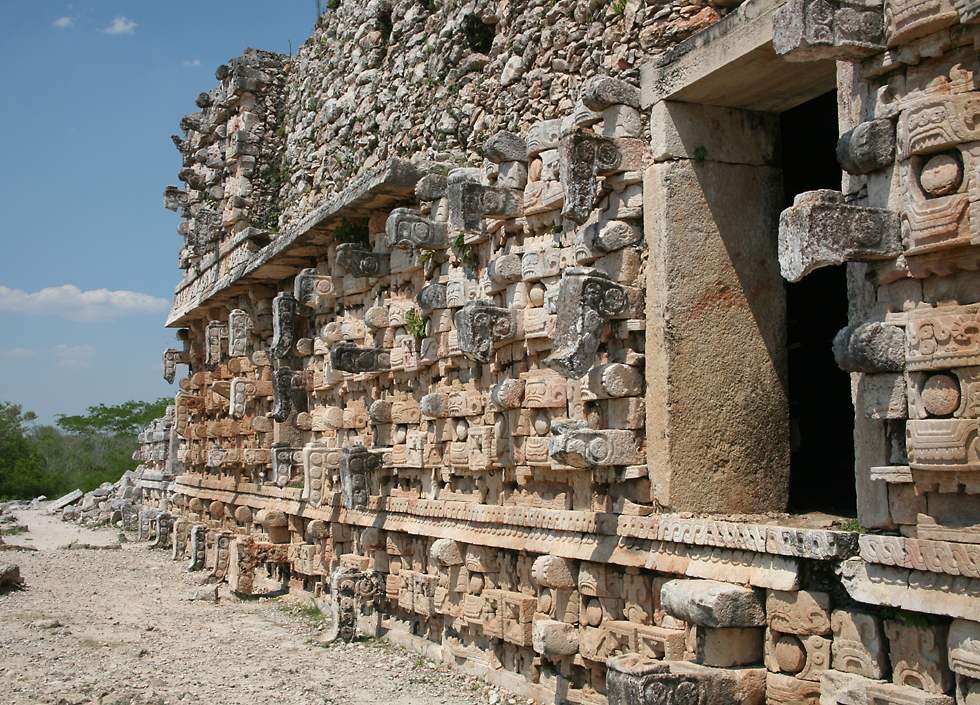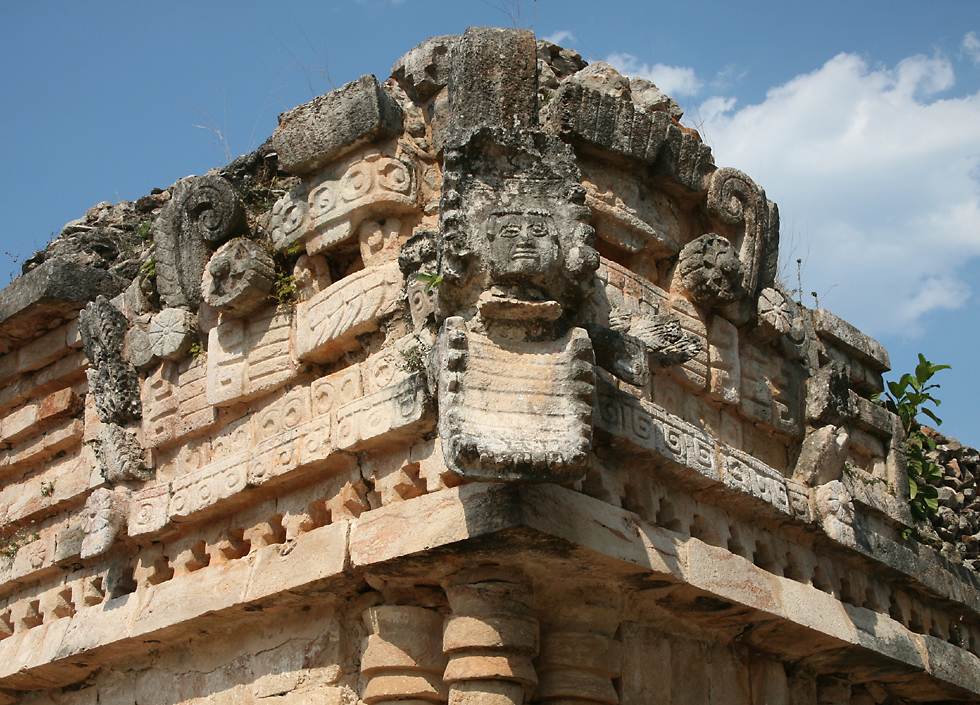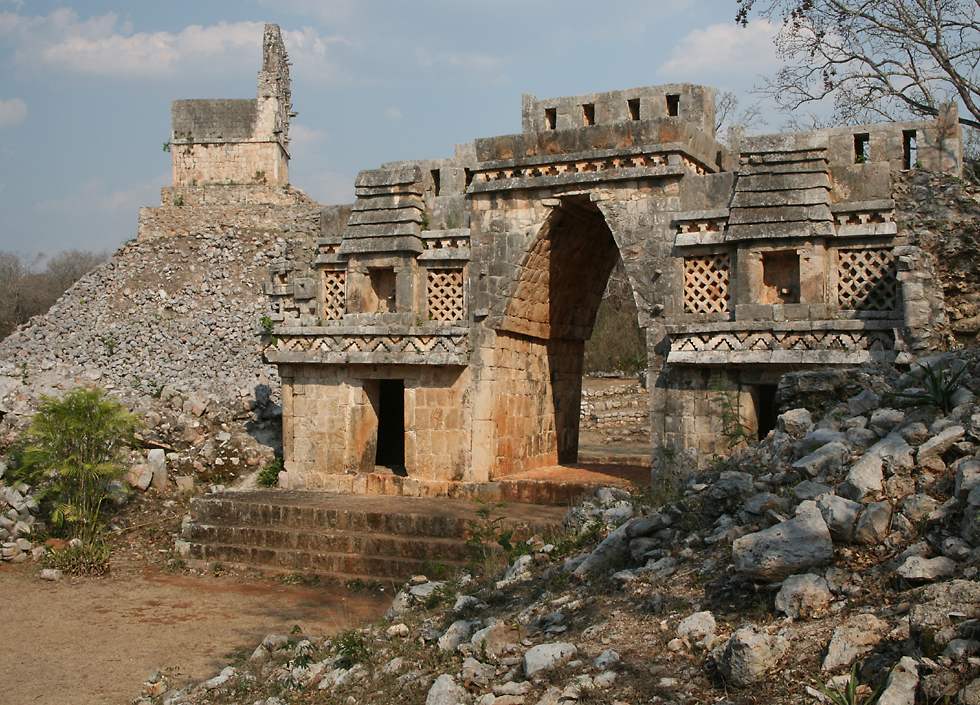Highlights of the Yucatan Peninsula
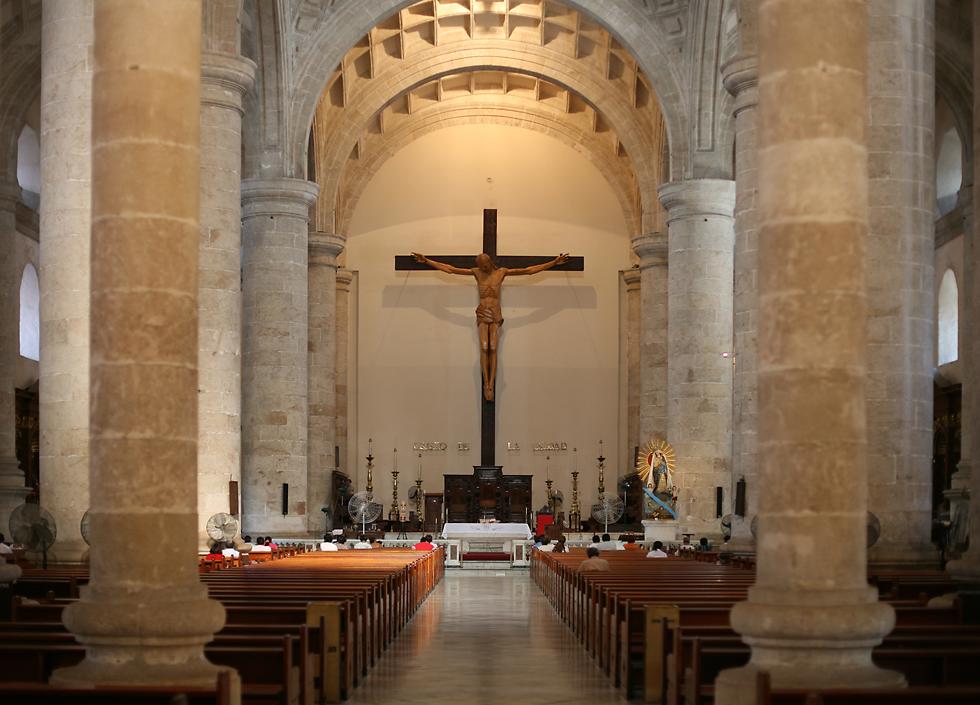 The
Yucatan Peninsula lies at the south-eastern corner of Mexico.
The peninsula is larger than Florida and includes the whole of the country
of Belize and
part of Guatemala,
however this page is just about the part of the peninsula which is in Mexico.
The
Yucatan Peninsula lies at the south-eastern corner of Mexico.
The peninsula is larger than Florida and includes the whole of the country
of Belize and
part of Guatemala,
however this page is just about the part of the peninsula which is in Mexico.
Until fairly recently the Yucatan was always considered somewhat separate from the rest of Mexico, but that isolation definitely ended when the government decided to develop the almost uninhabited north-eastern corner of the peninsula, which they named Cancun. Now almost 200 flights arrive every day, depositing about four million tourists each year. Most visitors spend the time going wild on the beach and perhaps doing day trips to sites around the closer parts of the peninsula. Cancun has a beautiful location, but it's not the sort of thing I'm interested in. Instead, after getting laid off in April of 2009 I took a month-long vacation, including about a week in the Yucatan. I started off with two or three days of scuba diving on the island of Cozumel, then rented a car and did a circuit around the peninsula. I'd heard good things about the city of Merida, which is the capital of the state of Yucatan and by far the largest city. Unfortunately I got lost driving into Merida and its charms were entirely lost on me, since they center on music and dancing, which are of as little interest to me as the beaches and discos of Cancun. I was hoping for some good architecture, but the only slightly interesting building for me was the cathedral, which you see here. |
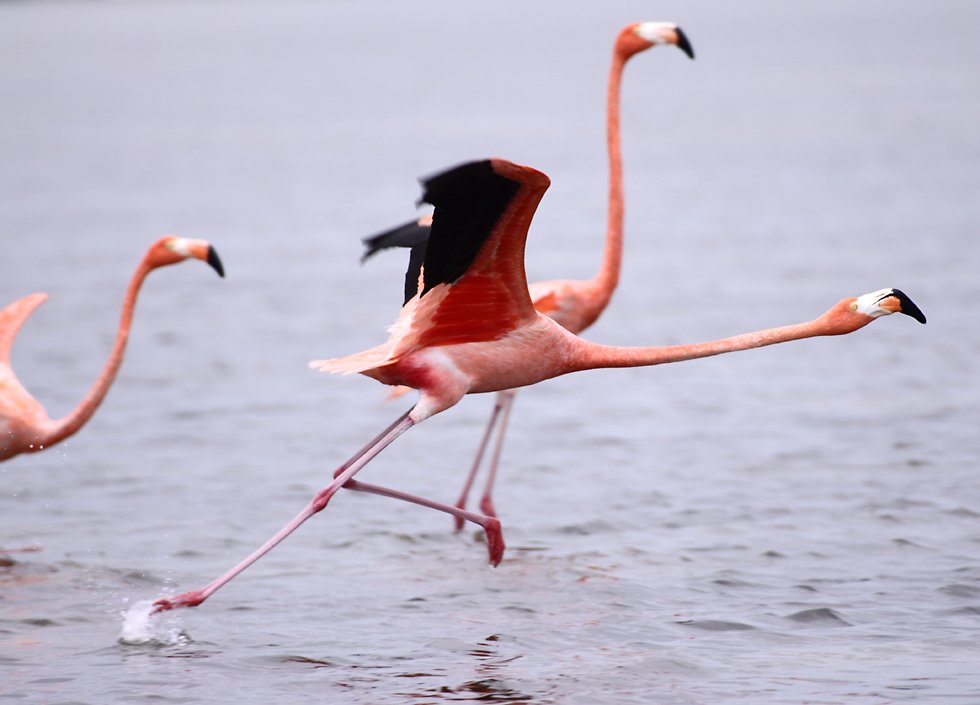
Merida does have attractions for people like me who are interested in architecture and nature, with lots of Maya ruins nearby, and flamingos which live in the nature reserves on the coast near Celestun, about 80 kilometers west of the city. However I didn't go to Celestun! I'd already been to the nature reserve at Rio Lagartos on the northern coast and seen the flamingos there. This turned out to be a good move, the tour there was a lot cheaper than the equivalent tour at Celestun, and when I got to Merida I heard that there were only a handful of flamingos at Celestun at that time. However, I got to see about 80 or 100 all together in a group at Rio Lagartos, as well as many of the other species of waterbirds of the Yucatan. |
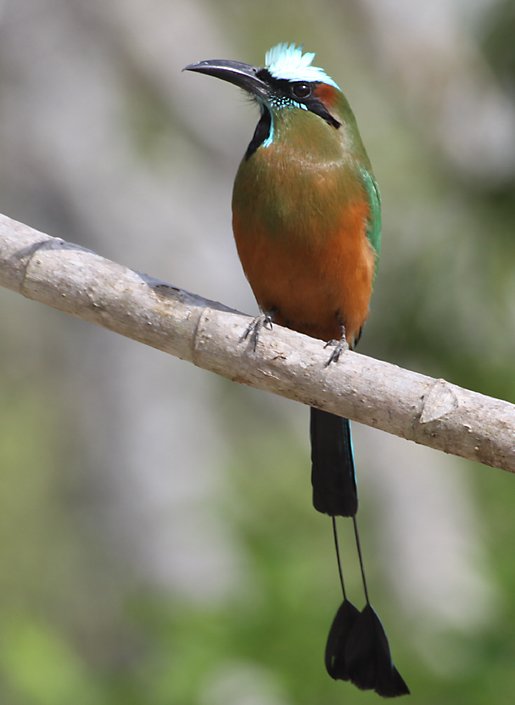
Bird watchers will find that there are plenty of birds inland, too, like this blue-crowned motmot that was at the Dos Ojos cenote. The blue-crowned motmot is fairly common around the Caribbean basin, and even down into South America. It's sometimes called the "clock bird" because of the way it twitches the two "rackets" at the ends of its tail backwards and forwards, like the pendulum of a clock. If you keep your eyes open then you can also see motmots at the Maya archaeological sites, like Chichen Itza and Kabah. |
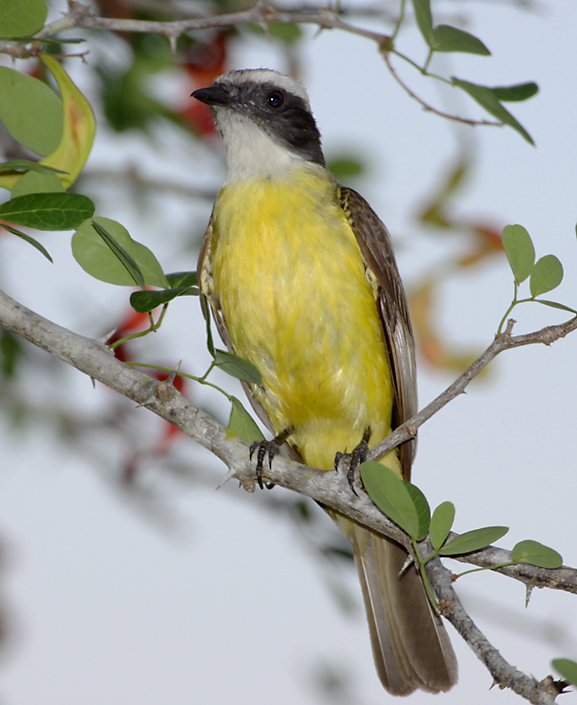
The Great Kiskadee is even more common than the blue-crowned motmot, though not as spectacular. It has an even wider range, all the way from Texas down to Argentina and Uruguay and, unlike the motmot, it can be found in cities. Although they belong to a group of birds called flycatchers, they'll eat almost anything, from insects to rodents, lizards and fruit. They're also very feisty, they'll mob hawks and other raptors to drive them away. The Great Kiskadee's call is said to be similar to the Spanish words "bien te veo", which in English means "I see you well". |

The lineated woodpecker is flashier than the Great Kiskadee. This one was at the very large Maya city of Chichen Itza, and the red mark under its bill identifies it as a male. Like other woodpeckers, this one uses its stiff tail feathers to brace itself against the tree its climbing, hanging on with its large and powerful claws as it pecks away looking for insects under the bark. |
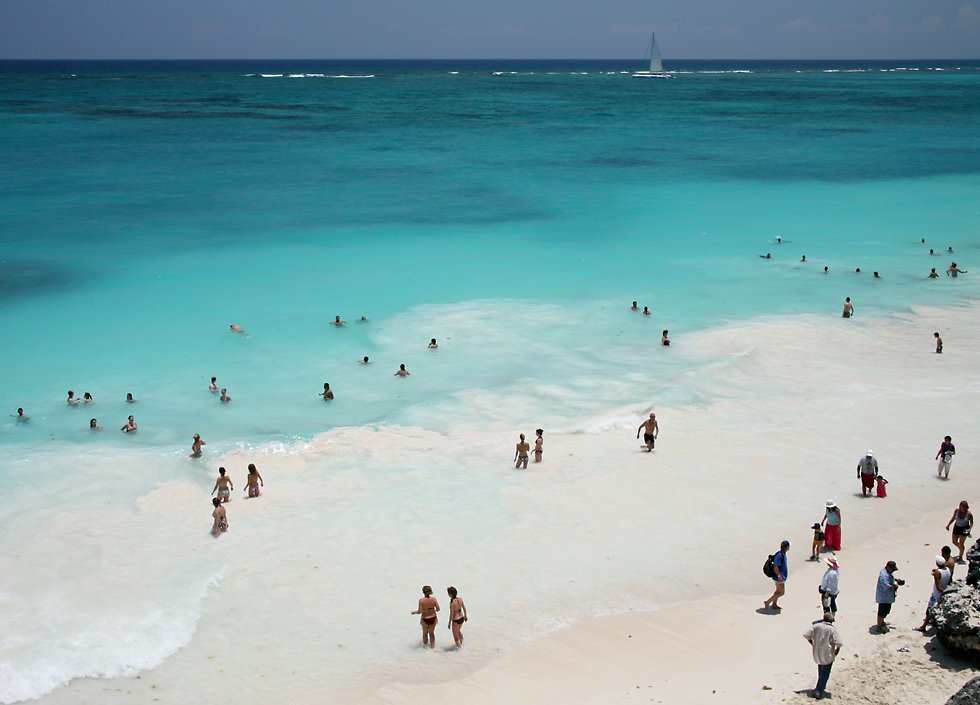
Another option, of course, is to go to any of the white sand beaches which border the turqoise colored Caribbean Sea along the peninsula's eastern shore. This is the only beach I visited, and only because it's at the Maya site of Tulum, not far south from where I'd been diving off the island of Cozumel. |
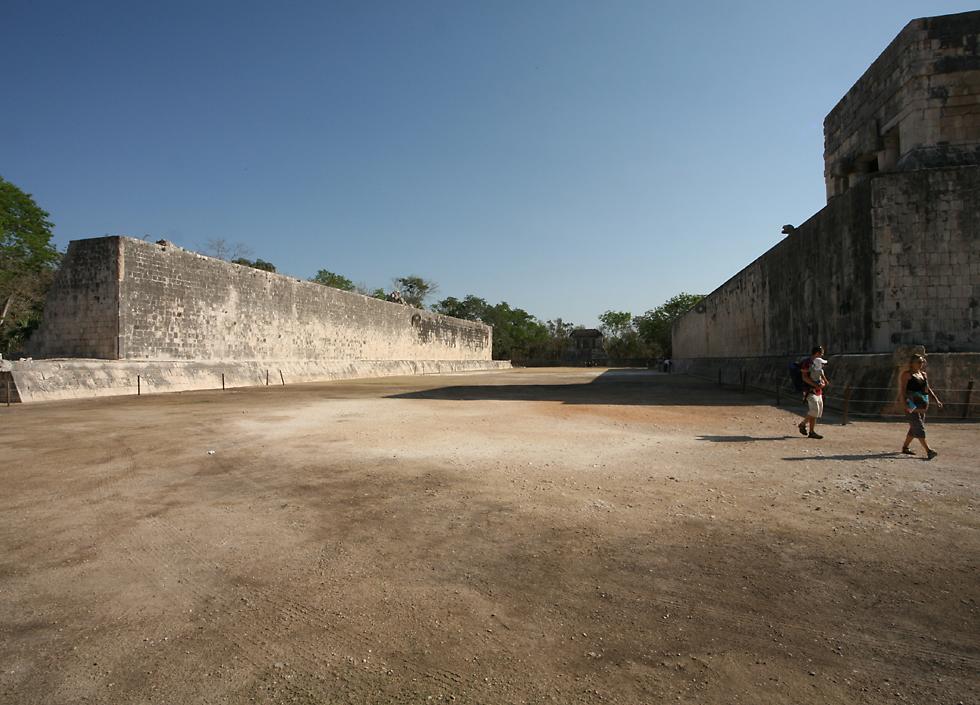
The Great Ball Court at Chichen Itza measures 166 meters long and 68 meters wide, and with walls 12 meters high, it's by far the largest ball court anywhere in Mesoamerica. It's also unusual in having vertical walls, rather than a combination of sloping and vertical surfaces. Carved into the walls are depictions of the members of two ball game teams, one of whose members has been decapitated, with seven streams of blood coming out of the wound. The Mesoamerican ball game was played for over 3000 years from Nicaragua in the south and possibly as far north as Arizona in the USA. Although it had varying rules throughout history and at different locations, the same basic game was played by many cultures, including that of Teotihuacan, the Maya, Olmecs and Aztecs. The game involved hitting a rubber ball weighing up to 9 pounds, either with parts of the body like the hips or sometimes with an implement. The ball had to be kept in play, and in later versions of the game there was a stone hoop (visible in this photo about half-way down the court and about 10 meters up both walls) through which the ball had to pass. The game was also played recreationally and it seems to have been a way of avoiding war between neighboring groups - sometimes one king or ruler would play against another to see who would serve the other. For elite players at a major religious event it was a very brutal and barbaric contest, since at the end of the game the players from one of the teams were killed as human sacrifices. Strangely enough, no-one is quite sure whether it was the losing team which was sacrificed, or the winning team, however it's possible that it was a great honor to be sacrificed, and that being killed would guarantee a better afterlife. Even in non-sacrificial games it was easy to be killed or seriously injured if you were hit hard by the solid rubber ball. |
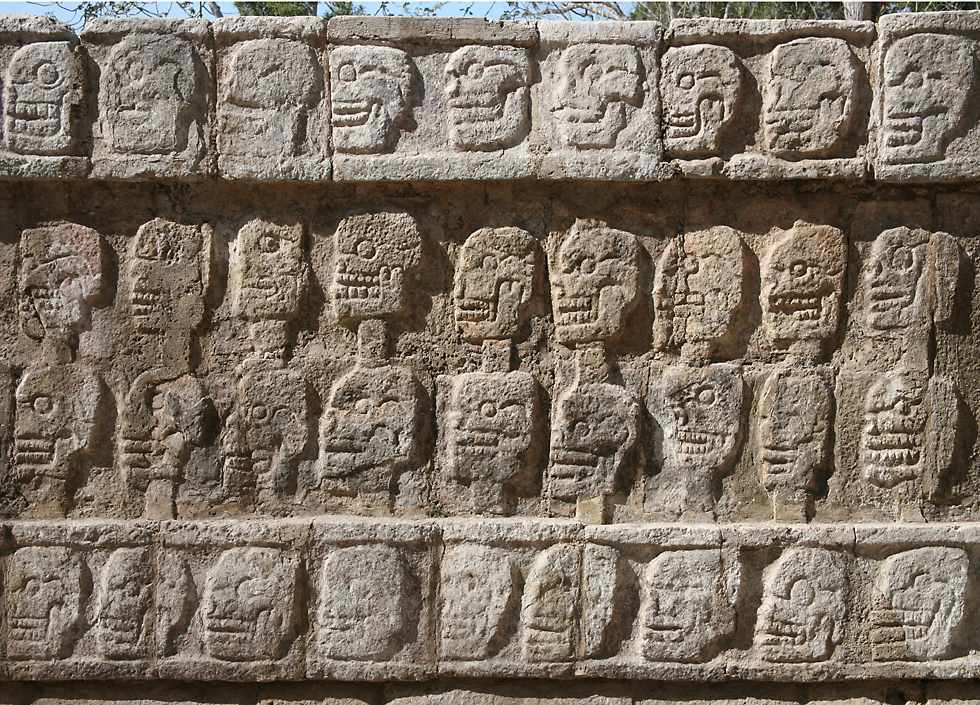
The Tzompantli is a low stone platform near the Great Ball Court at Chichen Itza, whose purpose was to serve as a place to display the skulls of sacrifical victims, perhaps those of the ball players themselves. Carvings of skulls surround the walls around the platform, with stairs leading to the top. The name tzompantli refers to large wooden racks used by different civilizations throughout Central America, with horizontal or vertical poles onto which skulls would be impaled. As you can see from this carving, at Chichen Itza the poles were vertical. At the Aztec Templo Mayor in the middle of Mexico City, there's an even more impressive Wall of Skulls which have been covered in stucco. At this same place a tzompantli was constructed to hold the skulls of Spaniards killed during the initial attempt to conquer the Aztecs, as well as the skulls of their horses, which were a huge novelty in an area where there had previously been no beasts of burden. One Aztec tzompantli was thought to hold up to 60000 skulls, though most were far smaller. |
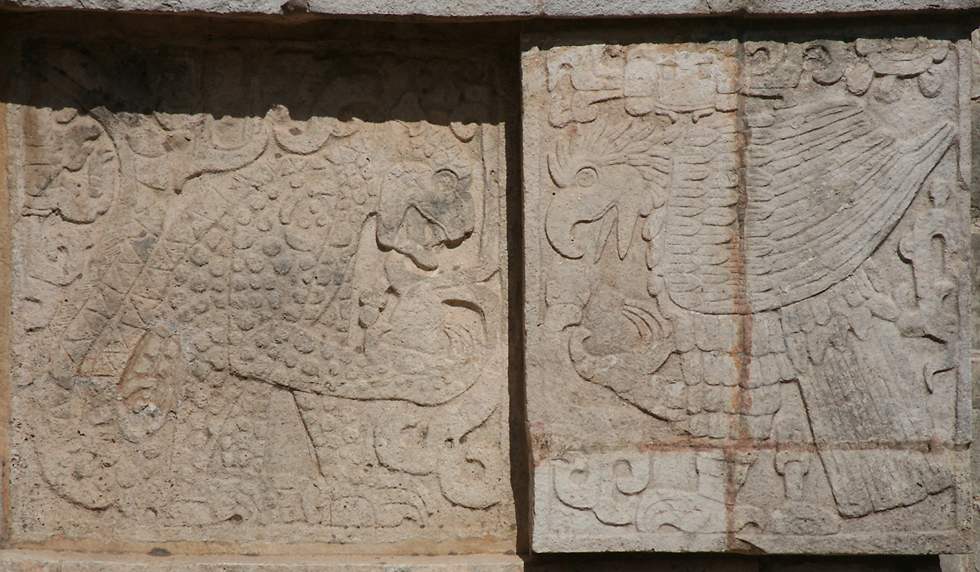
A jaguar and an eagle carved into the appropriately named Platform of the Jaguars and Eagles, near the Tzompantli at Chichen Itza. This carving is just as gruesome as those on the Tzompantli, since the jaguar and the eagle are both holding a human heart, which presumably has just been taken out of a human sacrifice. It's thought that the bird which is depicted is a harpy eagle, the largest and most powerful raptor in the Americas, quite capable of taking a monkey or sloth from a tree and carrying it away. |
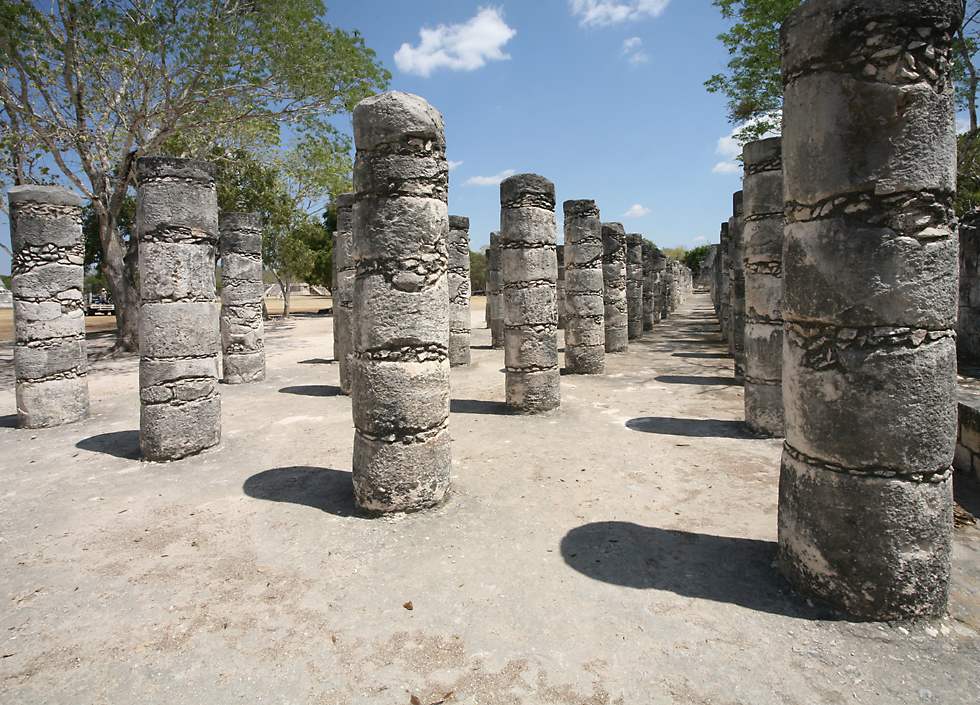
This is part of the Group of a Thousand Columns near the Temple of the Warriors at Chichen Itza. At one time these columns would have supported a roof made of wood and possibly thatch. |
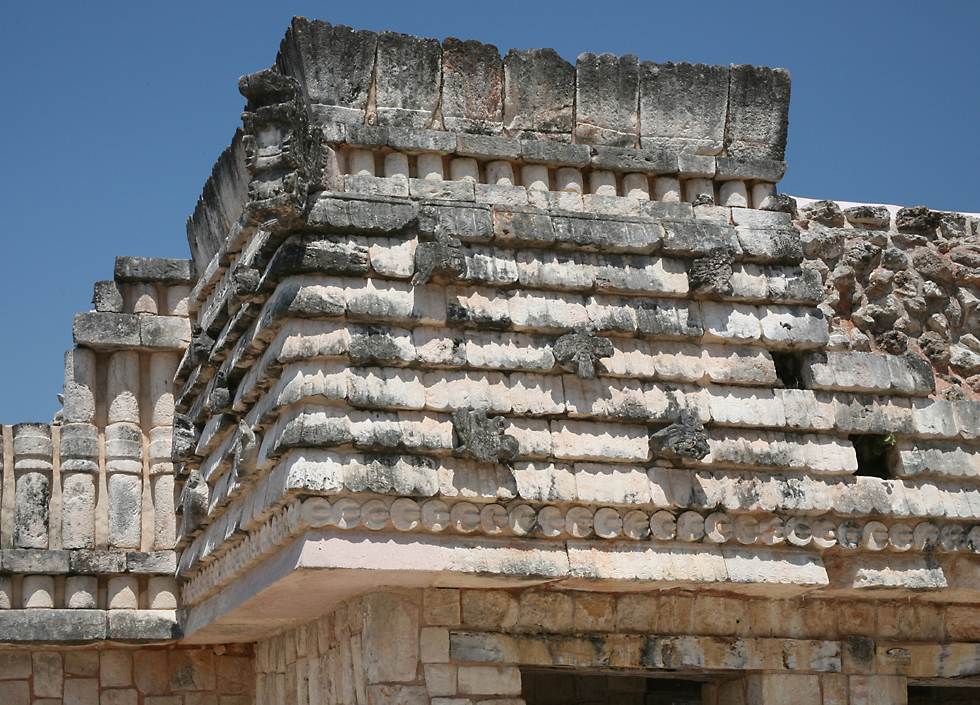
The Quadrangle of the Birds is a small square lined with buildings at the base of the Pyramid of the Magician at Uxmal. It gets its name from the parrot carvings you see here, attached to tile-like blocks carved into shapes like palm leaves, or something similar. As you can see, these are just two decorative elements present in this building, alongside ornamental pillars and a man's head emerging from the mouth of a snake, as at Labna, in both cases a reference to the Quetzalcoatl myth. Ornate decoration is very characteristic of all Maya cities, but those at Uxmal are particularly well preserved and ubiquitous, covering the walls of most buildings. The cities in this region follow what's called the Puuc architectural style, characterised by buildings with plain lower areas but highly decorated upper surfaces, and artificial pillars like the ones in this photo. |
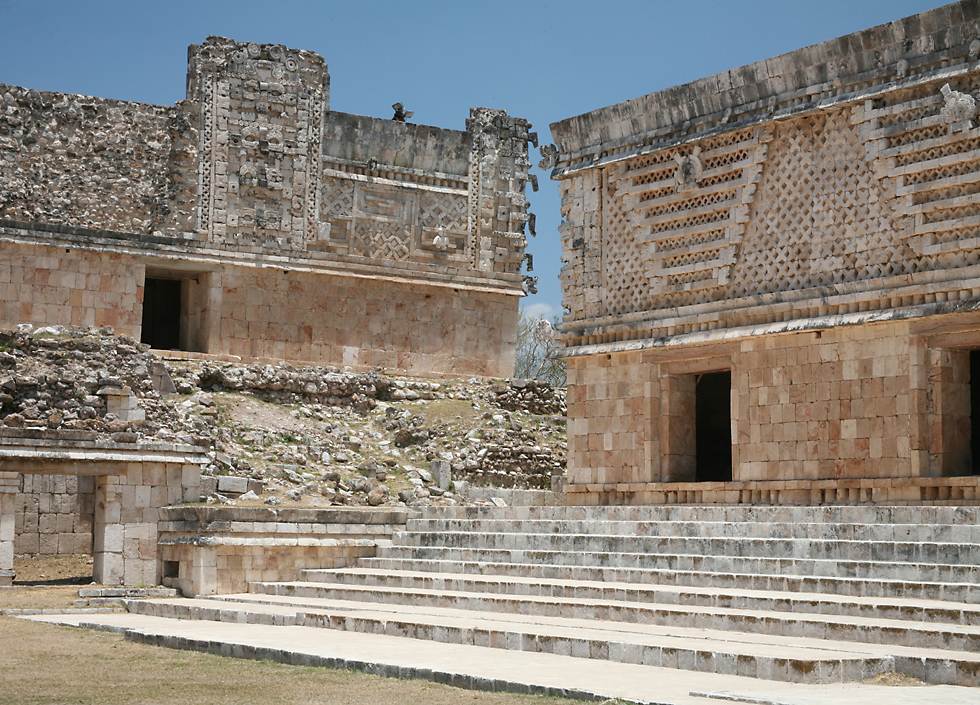
Two of the large buildings in the Nunnery Quadrangle at Uxmal. The four buildings in this large square are built at different levels, which might have a cosmological significance, along with their alignment. Whether that's correct or not, it's certainly true that all four buildings are intricately decorated, with geometric patterns, snakes, masks of the rain god Chac, and many other different figures. |
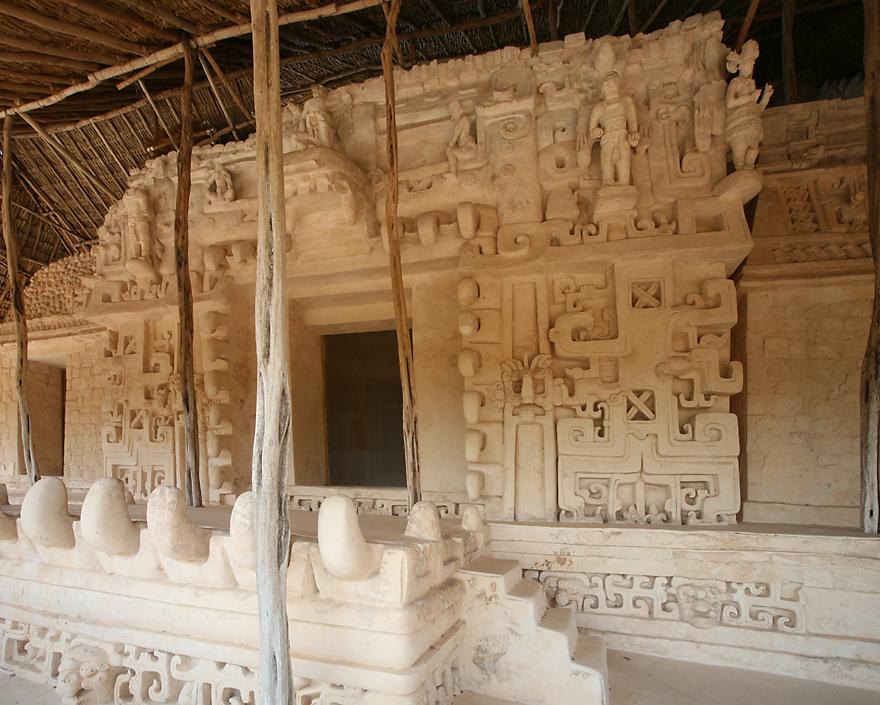
The Maya city of Ek Balam ("black jaguar") is a recently opened site which is between Cancun and Chichen Itza. It's not a large site, but there are some very substantial structures, the largest of which is the 160 meter long and 29 meter high Acropolis. Ek Balam was occupied for a very long time, and pre-dates the much larger city of Chichen Itza, which is about 65 kilometers away. Ek Balam is unusual for having a low stone wall around its perimeter, which might have served just as a demarcation between the inner and outer parts of the city, or might have also had a defensive purpose. There's also a semi-spiral building whose form is unique in the Maya world and whose purpose is unclear, though it might have been related to astronomical observations like the better-known building called El Caracol at Chichen Itza, which is also circular. A final unusual architectural feature is a small building with an arch in each of its four walls, which marked the beginning of several Maya roads or sacbeob. There are other arches marking the start of sacbes at Kabah and Labna, but none with four arches together. These unusual architectural features are of interest to archaeologists, but they wouldn't justify a trip to the site for most visitors. What makes Ek Balam a must see is a set of uniquely interesting statues and other decorative features about two-thirds of the way up the Acropolis, in an area now sheltered by a large thatched roof. This part of the Acropolis was built as a tomb for the city's ruler, Ukil Kan Lek Tok. The entrance to the tomb is made in the shape of a huge jaguar's mouth with large fangs, and around the mouth the walls are covered with decorations in high relief. When he died the ruler was placed in the tomb together with treasures including gold, jade and obsidian, and the whole tomb area was sealed under a thick stone wall. It was only rediscovered by accident when serious restoration work began at Ek Balam in 1997. |

The two most striking decorations around the tomb are these two winged figures, each over a meter high and standing on pedestals which jut out from the wall. It's very tempting to think of them as angels, but they were probably priests in ceremonial dress. Winged figures can be seen at other Maya cities like Mayapan, and even at other distant places in Mesoamerica such as Cacaxtla. The figure on the left is deformed, with a stunted right arm and only four fingers on that hand. Just as the Egyptians often elevated dwarves to positions of high office, so the Maya considered physical differences to be a sign of spiritual powers, so this person might have been made a priest precisely because he had these deformities. |
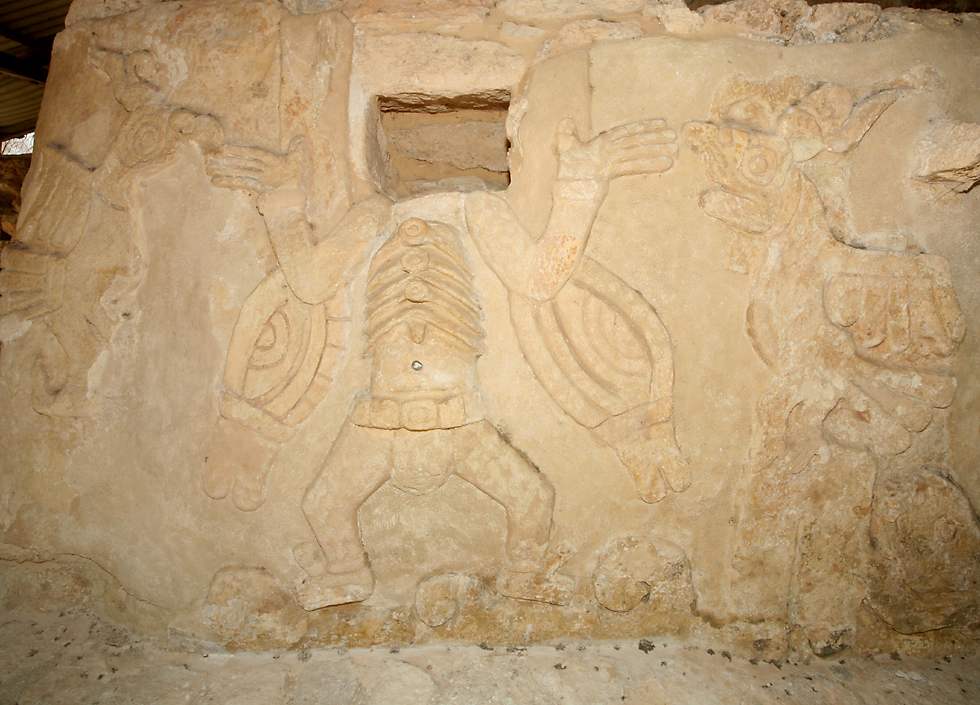
Mayapan is a Maya city founded quite late in the history of the civilization, around 1007 AD, when many cities elsewhere were already collapsing and being abandoned. During its 250 year period of power it exerted control over a large area including major cities like Uxmal and Chichen Itza. There are many architectural similarities between Mayapan and Chichen Itza, but the quality of the buildings at Mayapan is far lower than the earlier buildings at Chichen Itza, a sign of the Maya civilization's impending collapse. At Mayapan there are over 4000 stone structures scattered around a four square kilometer area bordered by a nine kilometer long stone wall, but the most interesting buildings are in the small ceremonial center area. In this area at the base of the main temple, a winged figure stands between two parrots. A niche above the figure would have held a head, either made out of precious materials or a real skull perhaps covered in stucco. |
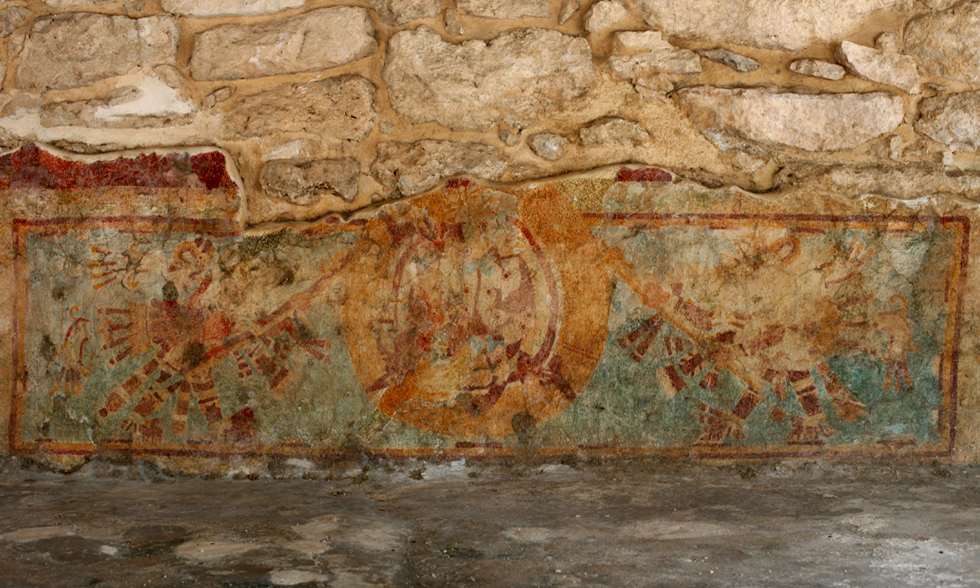
After the military defeat of Mayapan and its destruction by fire in 1441, the last remnants of central government in the Yucatan disintegrated and the individual Maya cities fell into a state of ongoing warfare with each other. When the Spanish arrived the people they met told them that they were men of Mayapan, and this is how the name "Maya" was applied to the entire civilization, both here in Mexico and throughout what are now the countries of Belize, Guatemala, El Salvador, Guatemala and the western part of Honduras. At the base of the temple of Kukulcan at Mayapan is an area with interesting stucco work and murals. Here you see a mural depicting two men with wooden poles holding up a circular banner, possibly a reference to the city's name, which means "Banner of the Maya". |
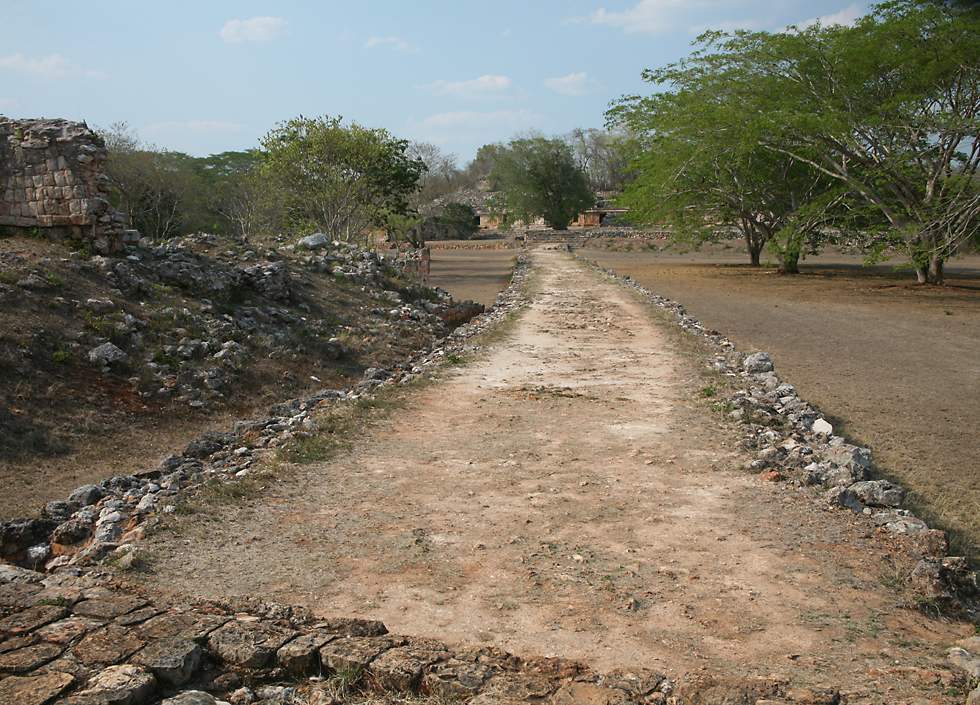
The Maya constructed an elaborate system of elevated roads between major towns and cities using crushed limestone. The limestone is bright white, so they named this type of road a "sac be", meaning "white road", the plural being sacbeob. Since the Maya didn't have horses or other pack animals, and also lacked wheeled vehicles, these roads were only used by pedestrians. The remarkable engineering feats of the Maya are even more amazing considering they didn't have metal tools, but achieved all that they did as a stone-age civilization. |
